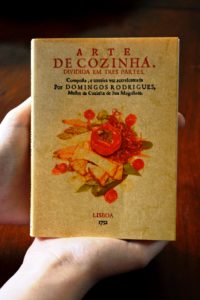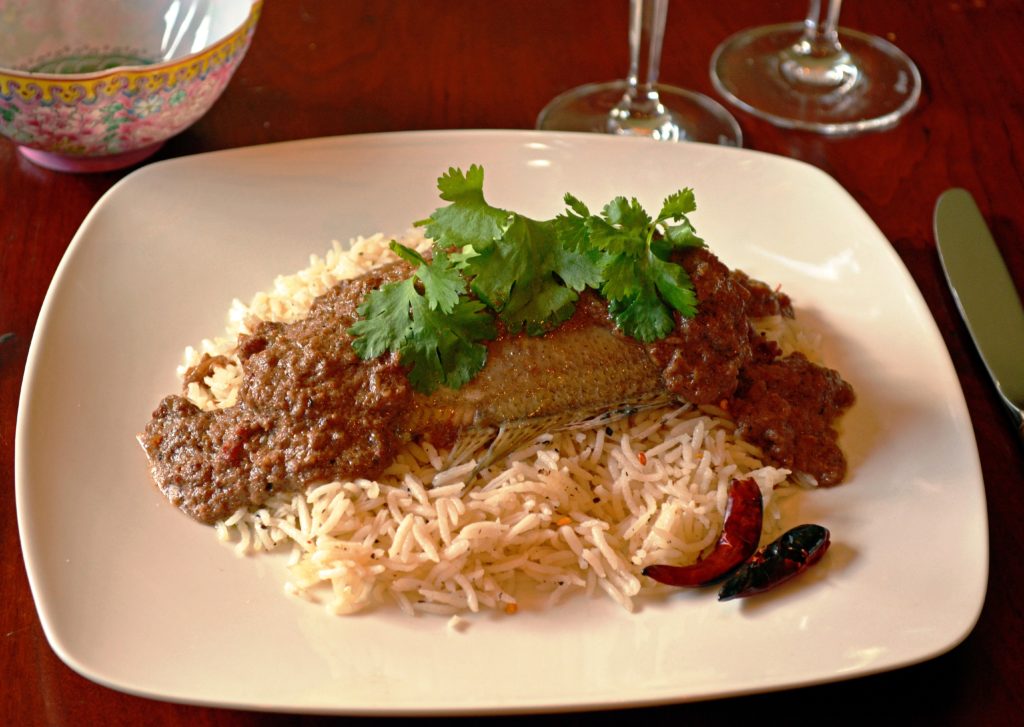
Rodrigues was a cook for the royal household of Portugal who lived from 1637 to 1719, and Arte de Cozinha was the first important cookbook published in Portuguese and was reprinted many times since its initial publication. My copy is a facsimile of the 1732 edition, but I checked the curry recipe against versions on the internet from 1680 and there is no change between the editions.
The recipe was written a full hundred years before Glasse’s curry and it is indeed a very different dish. For starters, this curry is really just a robust sauce or relish to be spooned over poached fish or meat that sit atop salted rice. It is not fish or meat cooked in lots of sauce until tender that is then eaten with plain or flavored rice. It also calls for a large amount of rice. In short, the proportion of meat, sauce and rice in Rodrigues’ curry are different from many curries today. Certainly this is true for those eaten in the west or in those served in international restaurants. However, “curry” as a sauce for rice with a bit of meat or vegetable is commonly eaten in modern home meals and also in food market stalls on the subcontinent and in the Indo Pacific.
The original recipe reads:
Caril para qualquer peixe
Afogadas duas cebolas bem picadas em uma quarta de manteiga de vaca, deitem-lhe uns poucos de camaroes, ou amêijoas, com o leite de uma quarta de amêndoas e, cozendo-se tudo até que fique um tanto grosso, tempere-se de adubos. Feito isto, coza-se meio arrátel de arroz em água e sal, ponha-se no prato e, sobre ele, algumas postas de peixe que quiserem, cozidas em água, e deite-se por cima o caril. Deste modo se faz também caril para carne, mas nao leva marisco.
A liberal and functional translation of this is:
Curry for any fish
Sauté two minced onions in one pint of unsalted cow’s butter. Add a few shrimp or clams along with a pint of almond milk and cook until the sauce has reduced a bit. Season with spices. Cook a half pound of rice in salted water. When the rice is done put it on a plate. On top of the rice place some poached fish and spoon or pour the sauce over the fish and rice. Works well with meat, but not for seafood.
Written in a modern form, the recipe looks like this. (Please note that I made some changes to the original recipe, such as reducing the amount of butter and almond milk used. Other choices are discussed below.)
Domingos Rodrigues’ Fish Curry
Ingredients
2 sticks unsalted butter
2 large yellow onions, minced
10 shrimp, peeled, deveined and diced
1 -1½ cups unsweetened almond milk
1 teaspoon salt
3 teaspoons black peppercorns, lightly crushed
2 green or finger-hot chilies, chopped
1-3 teaspoons malt vinegar
Masala
6-7 dry red chilies (Kashmiri are best)
3 tablespoons coriander seed
3 teaspoons cumin seed
2-inch piece of ginger, chopped
8-10 cloves of garlic
2-4 tablespoons finely ground coconut
2 ½ teaspoons tamarind concentrate
Water as needed to make a paste
Fish Poach
2-3 small, mild fish: croaker, pomfret, cod
Water in medium-to-large sauté pan to cover fish
½ teaspoon salt
½ onion, peeled, sliced and separated into crescents
1-2 tablespoons white vinegar
1 tablespoon whole, black peppercorns
Directions
Melt butter in a large saucepan over low heat. When butter is belted and warmed, add onion and sauté until they start to become translucent. Add the diced shrimp or clams and stir well. When the shrimp have colored and cooked, add the almond milk and stir well.
As the curry sauce warms, prepare the masala. You will need to stir the curry sauce from time to time as you prepare the masala.
Individually dry roast the chili peppers, coriander seeds and cumin seeds and set aside. Put all of the ingredients of the masala into a blender (you can pound it if you really want to), and add about 1/4 cup of water to start. Grind until you have a smooth paste, adding water in small amounts as needed for consistency.
Prepare the rice (I used basmati) in salted water any way you wish. Pour enough water in a large sauté pan to cover the fish, but do not yet place the fish in the water. Season the water with salt, onions, white vinegar and peppercorns, cover, and bring water to a boil.
Add the masala paste to the curry sauce and stir well. Cook over medium-low heat for at least 15 minutes to integrate the spices into the sauce. When garlic and spices are cooked, finish the sauce with a bit of salt, peppercorns, diced green chili peppers and malt vinegar.
When the poaching water has boiled, uncover and reduce heat. Slide the fish steaks into the water, cover and reheat to a medium-to-high simmer. Do not boil. Cook fish for 5-8 minutes (less is better) and when done, remove from sauté pan to drain before setting atop the rice. When sauce is done, spoon over fish and rice in the amount desired. Tuck in for a delicious dish.

_______
As you can see, there is a great deal of room for creativity on the part of the cook and variation in the dish with the direction from the original recipe which reads, “season with spices”. To determine which spices to use, I consulted some modern Goan recipes for fish curry and constructed a recipe based on these. Of course, by 1680, the Portuguese had extended their presence in India beyond the Malabar Coast to Sri Lanka and up to Bengal in the northeast, but I chose to construct the curry based on Goan recipes simply because that was the “capital” of the Portuguese trading empire on the subcontinent, and the cuisine still bears the mark of their colonization.
Another thing that figured into the choice of Goan spices was the description of Goan curried fish by 16th Century Dutch traveler Jan Huyghen van Linschoten. Huyghen, who was Secretary to the Archbishop of Goa from 1583 – 1589, wrote: “Most of their fish is eaten with rice, which they seeth in broth, which they put upon the rice, and is somewhat sour, as if it were sodden in gooseberries, or unripe grapes, but it tasteth well, and is called Carriel, which is their daily meat.”
With this description, I felt good about using a lot of tamarind for bitterness, and also decided to prepare the water that the fish is poached in slightly, as Huyghen calls it a “broth”. Many historical recipes do not mention doing this, but most cooks do it. It is one of those unspoken directions that can subtly change the flavor of a dish. My additions were simple. I just added a bit of white vinegar in the water to help maintain the consistency of the fish, some cracked peppercorns and a few slices of onion.
I felt justified in using lots of chili peppers, as these had been eagerly adopted from the Portuguese by the Goans and Kanarese in the very early 16th Century. By the time Rodrigues was writing chilies had long been naturalized on the subcontinent. I did omit the tomatoes found in many modern Goan curries, because this fruit was not embraced by the Indians until the mid-19th-to-early 20th Century.
Coconut can be found in most modern Goan curries as part of the masala, but it is also mentioned in the 1563 edition of, Conversations on the simples, drugs and medicinal substances of India, by the Portuguese physician living in Goa, Garcia de Orta. Orta wrote, “With this Coquo pounded they make a sort of milk, and cook rice with it, and it is like rice boiled in goat’s milk. They make dishes with it of birds and meat, which they call Caril.”
The choice of fish was a bit challenging. I initially cooked this dish with mackerel, but found the strong flavor of the fish to pull against the spicy, bitter flavor of the curry sauce. The second time I tried the dish, I went with a milder fish called an Atlantic croaker (Micropogonias undulatus). The fish were caught locally and were very fresh when cooked, which was a positive factor in my decision-making process. The croaker worked well with the curry, and I recommend it or any other mild fish with this recipe.
Other interpretations of this dish are clearly possible given the great latitude for seasoning that Rodrigues’ recipe offers. I made my choices and was clear about why I made them, but recognize that other permutations are possible. The recipe as written is a mixture of hot, spicy and bitter which works well with fish. There are titles of other curries in Arte de Cozinha – a Flounder Curry and a Lamb Curry. Alas these are just titles without ANY ingredients or method and like ideal forms will remain just out of reach. (Words, interpretation of historical recipe, and photographs by Laura Kelley.)
